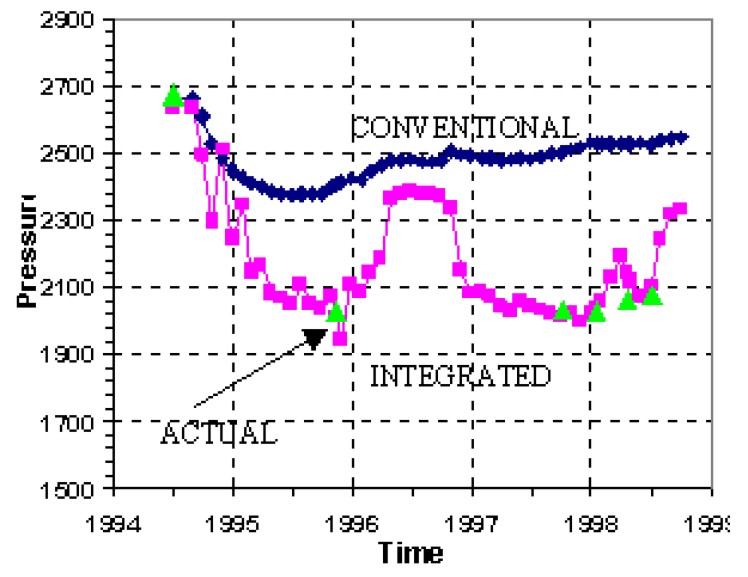

Analysis of Log Data and Reservoir Modelling
The Application of Fuzzy Logic and Genetic Algorithms to Oil Exploration. The PhD student Steve Cuddy and I have developed methods to improve the analysis of wireline log data. A range of methods have been studied and developed, including: (1) genetic algorithms, (2) fuzzy logic, (3) neural networks, and (4) principal component analysis. While some methods were more successful than others, combining genetic algorithms and fuzzy logic (GAFL) proved most powerful for suite of downhole data. There is a large range of different applications for these techniques including the calculation of porosity, permeability, hydrocarbon saturations and clay properties as well as repairing logs with missing data.[pdf]

Track 4 contains the measured permeability on cores (green), the calculated permeability from a poroperm crossplot (red) and the permeability predicted from GAFL using other tool data as inputs.
Predicting porosity and hydrocarbon saturation using cuttings gas data. One particular application of the genetic algorithm/fuzzy logic approach that has been very successful is the calculation of useful reservoir parameters from cuttings gas logs. We recognise that the hydrocarbon character ratio is correlated to the gamma ray data, the hydrocarbon balance ratio correlates well with density log and the hydrocarbon wetness ratio with the neutron density log. Since these ratios are (1) free and (2) available immediately on drilling, the quick GAFL analysis using them can give us early knowledge of porosity, permeability, hydrocarbon saturation and lithofacies at depth.
Cross-Discipline Integration in Reservoir Modeling. The extensive use of geostatistics is only useful if there is a drive towards integrating techniques and workflows in order that the natural heterogeneity of the reservoir can be modelled accurately. A PhD student applied this approach to the analysis of a heterogeneous reservoir and discovered that the water breakthrough, production and pressure data from the reservoir were much improved compared to conventional reservoir modelling. [pdf]

Here the new integrated reservoir modelling scheme (pink) predicts a reservoir pressure history that is very different from that from conventional streamline reservoir modelling (dark blue), but one that fits the measured data (green triangles) extremely well.
Publications
Al Qassab, H.M., Fitzmaurice, J., Al-Ali, Z.A., Al-Khalifa, M.A., Aktas, G.A. & Glover, P.W.J., Cross-Discipline Integration in Reservoir Modeling: The Impact on Fluid Flow Simulation and Reservoir Management, Society of Petroleum Engineers, SPE 62902, 1-12, 2000.[pdf]
Cuddy, S.J. & Glover, P.W.J., The Application of Fuzzy Logic and Genetic Algorithms to Oil Exploration, In: Developments in Soft Computing, Physica Verlag, pp. 167-174, 2000.
Cuddy S.J. & Glover P.W.J., The Application of Fuzzy Logic and Genetic Algorithms to Reservoir Characterization and Modeling , in Soft Computing for Reservoir Characterization and Modeling Series: Studies in Fuzziness and Soft Computing, 80, Eds. P.M. Wong, F. Aminzadeh, M. Nikravesh, 219-242, ISBN 3-7908-1421-0, 2002. [pdf]
Glover, P.W.J., Developments in Petrophysics: Book Review, J. Pet. Geol., 22(4), 459-460, 1999.
Glover, P.W.J., Wireline Logging: Multimedia Software Review, Pet. Geosci., 6(2), 2000.
Presentations
Glover, P.W.J. & G. Sinclair, Core Permeability: (Mis)understanding the basics, Permeability: From Pore Throat to Grid Block, AFES Symposium, November 1998.
Cuddy, S.J. & Glover, P.W.J., The application of genetic algorithms and fuzzy logic to the prediction of the physical properties of rocks, 25th General Assembly of the European Geophysical Society Nice, France, 25-29th April, 2000.
Al Qassab, H.M., Fitzmaurice, J., Al-Ali, Z.A., Al-Khalifa, M.A., Aktas, G.A. & Glover, P.W.J., Cross-Discipline Integration in Reservoir Modeling: The Impact on Fluid Flow Simulation and Reservoir Management, Society of Petroleum Engineers Meeting, SPE 62902, Dallas, 2000. Awarded best paper in section.
H.M. Al Qassab, H.M., Fitzmaurice, J.C., Al Ali, Z., Al Khalifa, M. & Glover, P.W.J., Cross-discipline data integration in reservoir modelling: optimizing fluid flow simulation and reservoir management, 26th General Assembly of the European Geophysical Society, Nice, France, 26-30th March, 2001. [pdf]
Pinto de Andrade, A.D., Cuddy, S.J. & Glover, P.W.J., Predicting porosity and hydrocarbon saturation of rock formations during drilling using genetic algorithms and fuzzy logic, 26th General Assembly of the European Geophysical Society, Nice, France, 26-30th March, 2001. [pdf]
S. Kay, S. Cuddy, S.J. & Glover, P.W.J., Innovative use of petrophysics for infill well drilling in the UK northern North sea: A case history from the Heather field, 26th General Assembly of the European Geophysical Society, Nice, France, 26-30th March, 2001. [pdf]
Glover, P.W.J., Predicting porosity, permeability frequency and hydrocarbon saturation using cuttings gas logs, Poster, EGU 2008, EGU2008-A-11734, 13-18 April 2008.[pdf]
© Copyright, Paul Glover 2008: Last updated 14/11/2008